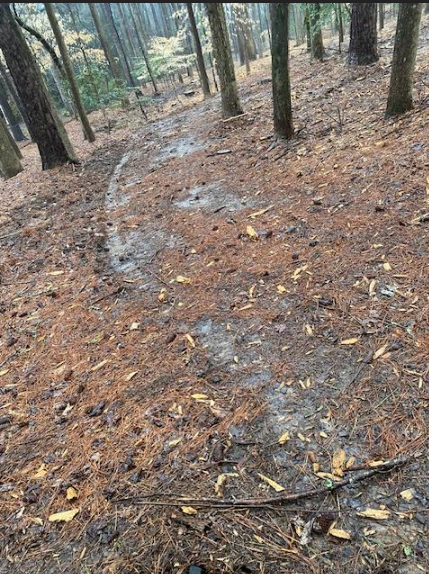
Section Branding
Header Content
Neighbors upset with how Dunwoody Nature Center handled a pine beetle infestation
Primary Content

Longtime residents in the Wyntercreek neighborhood are upset about how a pine beetle infestation at Dunwoody Nature Center was handled, saying it destroyed otherwise healthy trees and damaged their adjacent property.
Residents say that they were given no advance notice that the area behind their homes was set to be virtually clear-cut and claim the job was unprofessional and sloppy.
According to Dunwoody city officials, Javis Tree Service was chosen from among three vendors to remove 65 trees in several areas within the 21-acre park that were identified as infected by pine beetles.
Pine beetle infestation, according to the Georgia Forestry Commission, are mostly found in the south, and “can kill large numbers of healthy trees over many acres in a short period of time.”
“Promptly salvaging or destroying potential breeding material, such as pines that are severely damaged by wind, lightning, fire, disease, or insects, is important,” the GFC’s website said. “Chemical control of […] infestations under forest conditions is not recommended.”
Todd and Mary Cozart said they alerted the nature center staff of the infestation. Their son, who is majoring in forestry at the University of Tennessee, first identified the problem last Thanksgiving, Todd said.
“Some correspondence went back and forth, but we never heard back about a timeline for removing the trees,” Mary said. “Todd followed up, and the DNC told us they would let us know about the plan.”
Some trees were removed around Christmas, but the Cozarts said they were surprised on Feb. 2 when a large crew came to the area behind their home and started cutting down trees in a haphazard manner.

“They just chopped the trees down at the stump and the tree branches fell on top of the healthy trees and ripped off the canopy,” Todd said. “The machines that they were using left large gashes in the healthy trees, and in some cases, uprooted them entirely.”
The Cozarts said the crew worked long after dark that day, which they believe led to additional destruction of many of the healthy trees and bushes.
Holly bushes and dogwood trees were among the casualties. An inspection by Rough Draft on March 4 revealed deep scars in the trunks of the remaining foliage, large muddy trench marks where machinery moved through the area, and the destruction of a trail that leads from the street to the back of the park.
In addition, many of the felled trees remain on the forest floor.
“It looks like a tornado came through here,” Todd said.
City of Dunwoody spokesperson Jennifer Boettcher acknowledged that the neighbors whose property abuts the nature center were not informed in advance of the tree removal. After the fact, the Dunwoody Nature Center erected several signs that explained the reasoning behind the tree removal.
Boettcher said that after consulting with the nature center, “we kept about 30 percent of the trees on site as logs and mulch to provide habitat for wildlife and allow for natural decomposition. The mulch will also keep down invasive plants such as Privet and Russian Tea Olive, and eventually break down to make healthier soil.”

The area with the infested trees was dense, Boettcher said, but the tree service “used a surgical approach to try to save as many healthy trees as possible.”
“In the process, some healthy trees were impacted, but it does not appear that the damage will threaten those trees,” she said. “We will continue to watch them to ensure they remain healthy.”
As for the remaining pines, Boettcher said approved treatments were administered to help guard against future infestation.
However, the Cozarts found that a tree in their back yard was infested with pine beetles and recently paid $1,000 to have it taken down. Another tree just outside their fence on DNC property is also infested and dying rapidly.
Nancy Longacre, the executive director of the Dunwoody Nature Center said in a statement that “while we are devastated by the loss of so many trees due to the pine beetle disease, we are grateful that in partnership with the City of Dunwoody and Trees Atlanta, we can begin the reforestation process.”
“The selection of native trees will be carefully selected and planted in the fall of 2024 and spring of 2025,” she continued. “We also look forward to offering the community educational resources regarding tree care in the near future.”
The Cozarts said they don’t have a problem with the city or the Dunwoody Nature Center. In fact, both have enjoyed volunteering at the park and have used the trails extensively. The issue, they said, was the way the removal was handled.
“This is our money, the taxpayers, and the city should be spending it in a responsible manner,” Todd said. “The falling trees damaged our fence, we still have mulch all over our roof, and had huge chunks of wood all over the yard, which we cleaned up.”
The Cozarts said the city later repaired the fence, but the trenches and trail destruction remain more than a month after the project was complete.
“It still looks like a wasteland out there,” Todd said.
Boettcher said the reforestation process will include existing native trees such as American holly, beech, magnolia, and dogwood.
This story comes to GPB through a reporting partnership with Rough Draft Atlanta.

